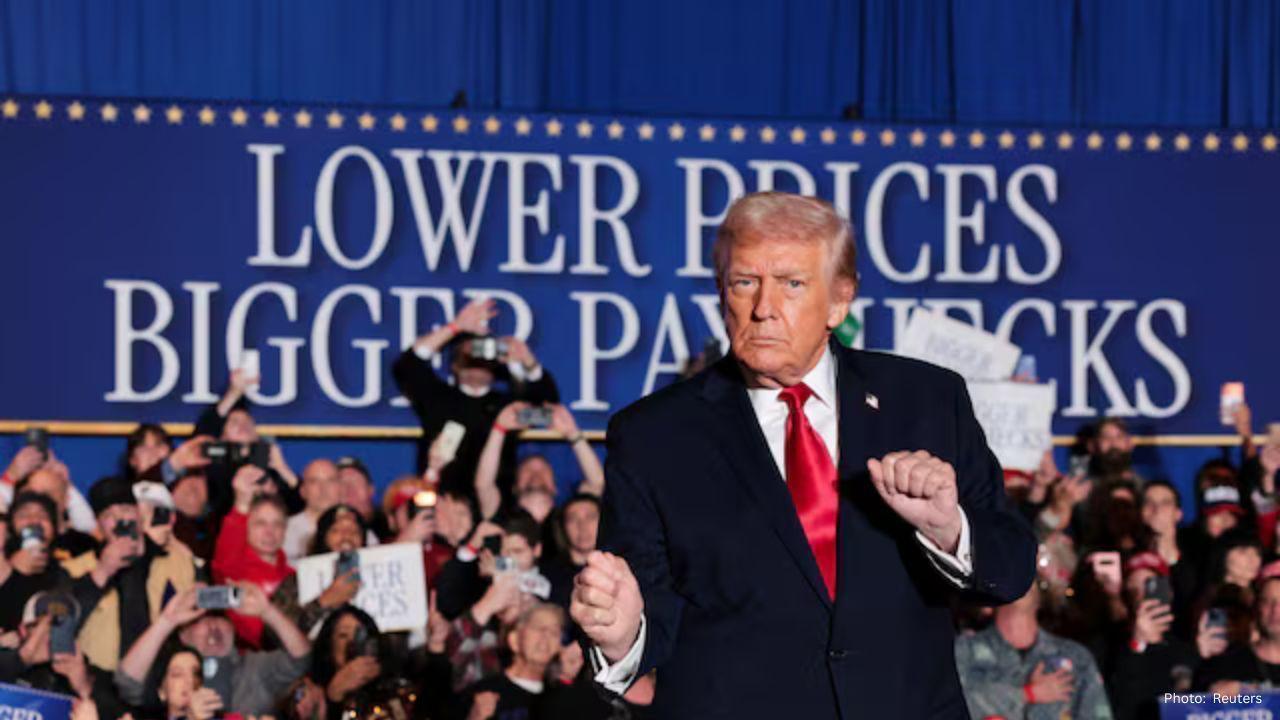
Post by : Monika
The Democratic Party in the United States is working hard to find a way to win back young male voters, who moved toward Republicans during the 2024 elections. Many political experts believe that if Democrats cannot reconnect with this group, it could hurt their chances in future elections, including the 2026 midterms.
Across the country, campaign strategists, digital experts, and political organizers are now discussing what messages will truly speak to young men. Some believe it’s about economics and job security, while others say it’s about identity, masculinity, and trust. Still, no single plan has yet united everyone in the Democratic Party.
Why Democrats Lost Young Men
In the 2024 presidential election, the Democratic Party noticed a major shift. Among men aged 18 to 29, former President Donald Trump gained around 46% of votes—a jump of seven points compared to 2020. This change set off alarm bells within the Democratic leadership.
For years, Democrats believed that young people, especially those in cities or attending colleges, were loyal supporters. But recent data showed that young men are becoming more conservative on cultural and political topics.
Experts say this happened for several reasons:
Republicans Spoke More Directly
Republican figures like Donald Trump, Ben Shapiro, and others on social media often talk about strength, freedom, and personal responsibility. Their language connects emotionally with many young men who feel unheard.
Social Media Influence
Conservative influencers dominate spaces like YouTube, TikTok, and podcasts. They mix humor with political messages, making politics feel more relatable.
Lack of Democratic Outreach
The Democrats never built a coordinated digital strategy focused on young men. While Republicans invested in youth-focused platforms and content creators, Democrats often relied on traditional campaign methods like speeches and TV ads.
Cultural Shifts
Some young men feel blamed or ignored in political discussions about gender, identity, and privilege. They see Democratic policies as not addressing their struggles—such as finding affordable housing, getting good jobs, or paying student loans.
As one campaign worker said, “We keep talking about progress, but for many young men, life feels stuck. They don’t see their future getting better.”
How Democrats Are Trying to Reconnect
To regain young men’s trust, Democrats are experimenting with several new methods. The party is no longer relying only on official campaign ads or rallies. Instead, they’re trying to speak to voters where they already spend time—on social media, gaming platforms, and podcasts.
1. Focusing on Economic Issues
The Democratic National Committee (DNC) has decided that the economy is the most direct way to reach young men.
A new set of ads launched on Labor Day focused on inflation, job growth, and wages. One ad showed a man buying groceries and beer while a voice said:
“This Labor Day, Republicans are making your beer more expensive.”
The goal was simple—to make young men see how Republican policies impact their wallets.
2. Partnering with Influencers
Instead of relying only on politicians, Democrats are now working with online influencers who already have loyal followers among young audiences.
These include Twitch streamers, YouTubers, and TikTok personalities who talk about sports, technology, gaming, or mental health. The idea is to make political discussion part of everyday online culture.
For example, one Democratic congressman recently appeared on a live stream with a gamer who has millions of young male followers. During their talk, they discussed not just politics but also video games and job opportunities in tech.
3. Using Podcasts and Informal Interviews
Many young men don’t watch traditional news or follow official campaign speeches. Instead, they prefer podcasts and relaxed online discussions.
To reach them, several Democratic governors and senators have started appearing on popular podcasts. These shows allow them to talk casually about their personal life, experiences, and beliefs, rather than giving formal speeches.
By showing more human sides, Democrats hope to seem relatable and authentic, two qualities that young men value highly in public figures.
4. Creating Viral Videos
Democratic groups have begun experimenting with short, emotional videos designed to grab attention.
One ad titled “Kidnapping Your Girlfriend” uses a dramatic story to make viewers watch till the end. It mixes suspense and emotion to spread a political message about safety and democracy.
Even though some people find such ads extreme, party media strategists believe that viral storytelling works better than traditional political talk.
5. Testing Grassroots Campaigns
Local Democratic groups are also running smaller community-based campaigns. In some cities, they organize events that combine music, job fairs, and voter registration.
At these events, speakers talk about student debt, rent prices, and wages—issues that young men face every day. The goal is to show that the party understands their real-life struggles.
The Challenges Democrats Face
While Democrats are trying hard, they face serious challenges that make their mission difficult.
1. No Unified Message
The biggest problem is that there is no single, clear message. Every campaign, influencer, or group has its own version of what works. Some talk about jobs, others about climate change, and others about social issues.
This lack of coordination makes it hard to build a strong national identity. In contrast, Republicans have maintained a consistent message about patriotism, freedom, and strong leadership.
2. Conservative Dominance Online
Right-wing influencers already dominate YouTube and podcasts. They release daily content that’s entertaining, funny, and emotionally charged.
Democrats, on the other hand, often release fewer videos and focus more on policy details—something young audiences may find boring.
3. Authenticity Gap
Many young men think Democratic politicians sound “scripted” or “too polished.”
A strategist explained, “Young guys can tell when someone’s being fake. They prefer a person who might say something imperfect but real.”
This authenticity gap makes it hard for Democrats to win trust, even when their policies could help those very voters.
4. Cultural Resistance
Some Democrats feel uncomfortable engaging in topics like masculinity or gender identity. But these are central to many young men’s experiences. Ignoring these issues leaves space for conservatives to control the conversation.
5. Testing Without Focus
The party is trying too many new experiments at once—different ads, influencers, and digital projects—without a shared strategy. This scattershot approach risks wasting resources.
What Democrats Can Do Next
Despite these challenges, political experts believe Democrats can rebuild support among young men if they take the right steps.
1. Talk About Real-Life Issues
Focus on everyday struggles like job security, rent, healthcare, and education costs. Instead of using abstract slogans, use personal stories that young men can relate to.
2. Be Honest and Real
Avoid overly scripted campaign videos. Speak naturally, even if it’s less polished. People connect with sincerity, not perfection.
3. Invest Long-Term
Don’t just target young men during election time. Build connections all year round through local events, music festivals, gaming tournaments, and youth organizations.
4. Empower Young Male Democrats
Let young male leaders and creators represent the party online. When young men see people like themselves talking about politics, they’re more likely to listen.
5. Compete in Digital Spaces
Democrats need to invest in podcasts, memes, video clips, and live streaming—not just traditional media. They must become a constant presence where young people already are.
6. Build a Unified Message
All campaigns—from local to national—should share one theme: that the Democratic Party is fighting for opportunity, fairness, and freedom for all, including young men.
The Bigger Picture
Winning back young male voters isn’t just about one election—it’s about the future direction of American politics.
Young men represent a growing portion of the voting population. If Democrats continue to lose their trust, the Republican Party could gain a lasting advantage.
For Democrats, it’s not just about changing how they talk, but also what they represent. They must show that they understand young men’s hopes, frustrations, and dreams.
From influencers and viral videos to podcasts and community events, Democrats are exploring every possible path. But success will depend on more than tactics—it will depend on authenticity, empathy, and understanding the real struggles of young men in today’s America.










OpenAI Highlights Growing Cybersecurity Threats from Emerging AI Technologies
OpenAI has raised alarms about the increasing cyber risks from its upcoming AI models, emphasizing s

Manchester City Triumphs 2-1 Against Real Madrid, Alonso Faces Increased Scrutiny
Manchester City secured a 2-1 victory over Real Madrid, raising concerns for coach Xabi Alonso amid

Cristiano Ronaldo Leads Al Nassr to 4-2 Victory Over Al Wahda in Friendly Face-Off
Ronaldo's goal helped Al Nassr secure a 4-2 friendly win over Al Wahda, boosting anticipation for th

Landon Donovan Challenges Australia Coach on World Cup Prospects
Landon Donovan counters Australia coach Tony Popovic’s optimism for the World Cup, expecting an earl

Mercedes-Benz Forms Landmark Partnership with WTA
Mercedes-Benz and the WTA unveil a significant partnership effective January 2026, with major invest

Abhishek Addresses Divorce Rumours Concerning His Family
Abhishek Bachchan confirms that daughter Aaradhya remains oblivious to divorce speculations, focusin